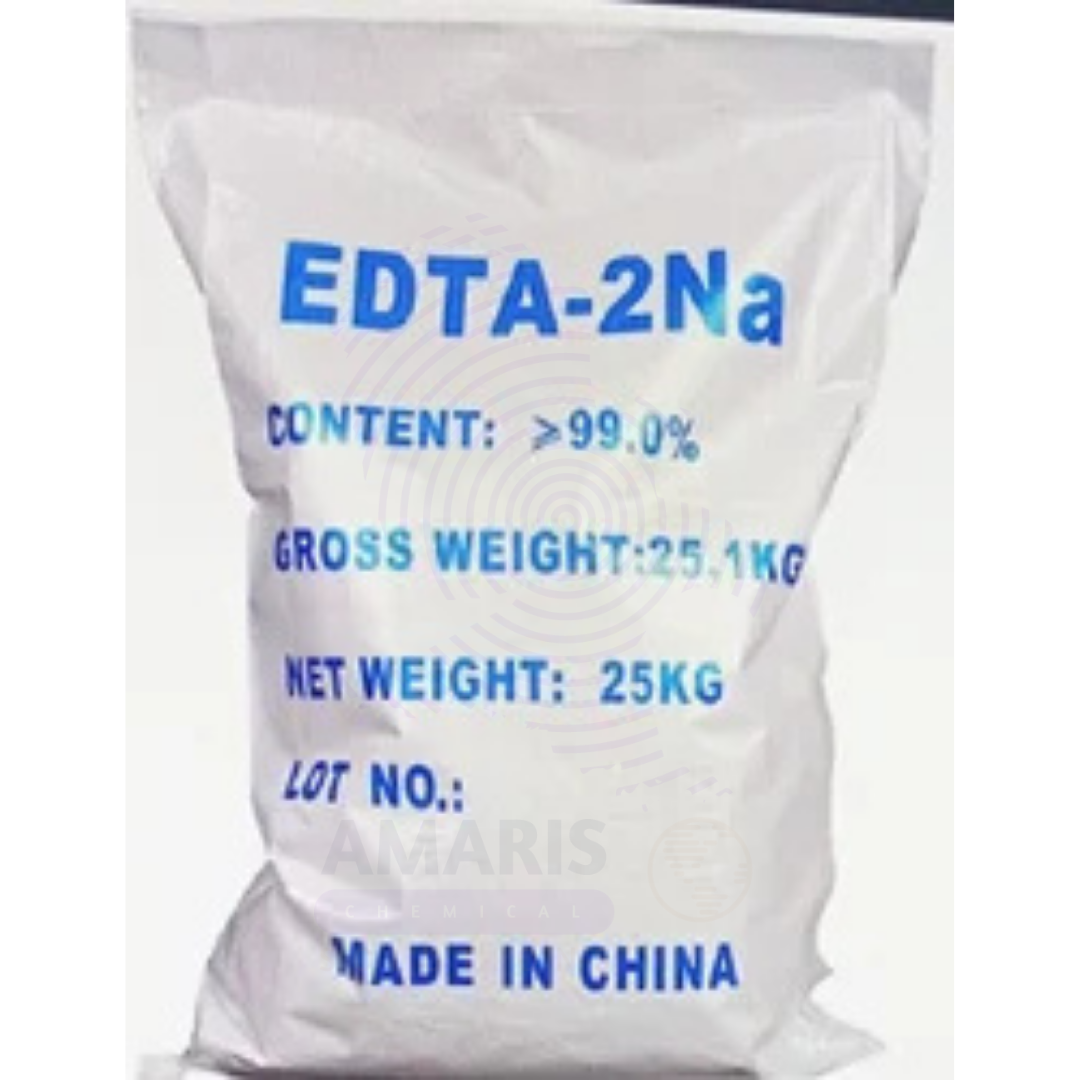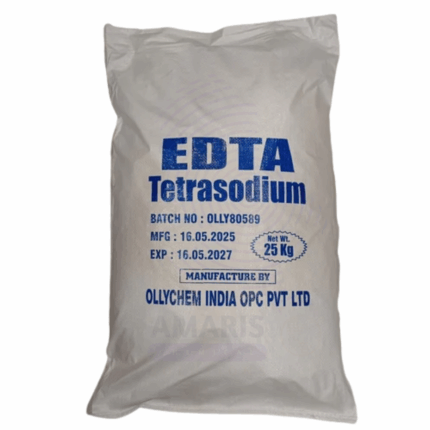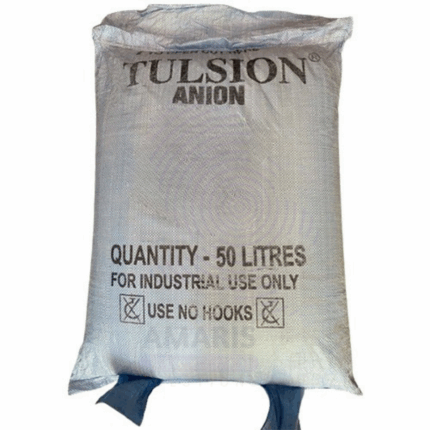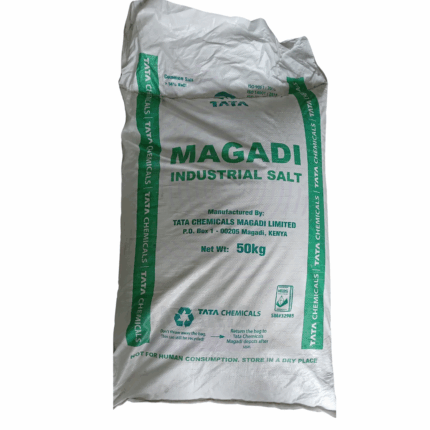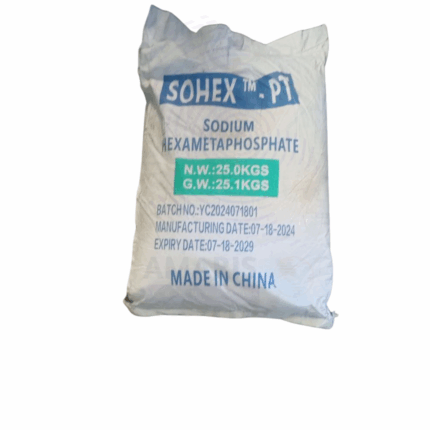EDTA Disodium Salt
EDTA Disodium Salt (Ethylenediaminetetraacetic acid disodium salt) is a widely used chelating agent that binds metal ions to form stable complexes. It effectively sequesters divalent and trivalent metal ions such as calcium, magnesium, iron, and heavy metals, preventing their participation in unwanted chemical reactions. This property makes it essential in a wide range of industrial, pharmaceutical, cosmetic, agricultural, and water treatment applications. The disodium salt form offers excellent water solubility and is often used in neutral to slightly alkaline systems.
EDTA Disodium Salt
Primary Uses
Water Treatment & Industrial Cleaning
- Used extensively to chelate metal ions in boiler feedwater and cooling water systems to prevent scale formation and corrosion.
- Acts as a metal ion scavenger in detergents and industrial cleaners to improve cleaning efficiency.
- Prevents discoloration and deposits caused by metal ions in pulp and paper processing.Pharmaceuticals & Medicine
- Employed as a chelating agent to reduce metal-induced oxidative degradation in formulations.
- Used in chelation therapy to treat heavy metal poisoning by binding and facilitating metal excretion.
- Stabilizes active ingredients in injectable and topical drug formulations.Cosmetics & Personal Care
- Added to shampoos, lotions, creams, and soaps to bind metal ions that cause product degradation and spoilage.
- Improves foam stability and texture in cleansing products by softening water hardness.
- Enhances product shelf life by preventing color changes and rancidity.Food Industry
- Used as a food additive (E385) to preserve color, flavor, and texture by binding metal ions that catalyze oxidation.
- Commonly used in canned foods, beverages, and processed products to enhance stability.Agriculture & Horticulture
- Serves as a micronutrient chelator to improve bioavailability of trace metals like iron, zinc, and manganese in fertilizers and foliar sprays.
- Prevents metal ion precipitation and enhances nutrient uptake in plants.
Secondary Uses
Analytical Chemistry
- Used in complexometric titrations to determine metal ion concentrations.Textile Industry
- Functions as a stabilizer and metal ion scavenger to prevent color fading and fabric degradation.Photography
- Utilized in photographic developers to control metal ion interference.
- Basic Identification Attributes
- Chemical Name (IUPAC): Disodium 2-[2-[bis(carboxylatomethyl)amino]ethyl-(carboxylatomethyl)amino]acetate
- Common/Trade Name: EDTA Disodium Salt
- CAS Number: 139-33-3
- HS Code: 2922.49.00
- Molecular Formula: C₁₀H₁₄N₂Na₂O₈
- Synonyms:
- Ethylenediaminetetraacetic acid disodium salt
- EDTA-2Na
- Disodium EDTA
- Versenate Sodium
- Physical & Chemical Properties
- Physical State: White crystalline powder or granules
- Color & Odor: White; odorless
- pH (1% aqueous solution): Approximately 4.5–5.5
- Solubility: Freely soluble in water; insoluble in ethanol and non-polar solvents
- Stability: Stable under normal storage; decomposes on strong heating
- Melting Point: Decomposes above 240°C
- Safety & Hazard Attributes
- Hazard Class (GHS): Not classified as hazardous
- Toxicity: Low toxicity; may cause mild irritation to eyes and skin on contact
- Exposure Limits: Not established
- Storage & Handling Attributes
- Storage Conditions: Store in a cool, dry place away from moisture and incompatible substances
- Container Type: Sealed polyethylene bags or drums
- Shelf Life: 2–3 years if stored properly
- Handling Precautions: Avoid dust generation; use PPE to prevent eye and respiratory irritation
- Regulatory & Compliance Attributes
- Approved for use in food, pharmaceuticals, cosmetics, and industrial applications by FDA, EFSA, and other regulatory bodies
- Complies with REACH and other environmental and safety regulations
- Environmental & Health Impact
- Biodegradability: Slowly biodegradable; persists under some environmental conditions
- Ecotoxicity: Low to moderate; avoid release in high concentrations to aquatic environments
- Bioaccumulation: Not expected
Carcinogenicity/Mutagenicity: Not classified as carcinogenic or mutagenic
Safety Handling Precautions
PPE Required:
- Dust mask or respirator (for powder handling)
- Safety goggles
- Gloves (nitrile or latex)
- Protective clothing or lab coat
Handling Guidelines:
- Handle in well-ventilated areas
- Avoid inhalation of dust and eye contact
- Use dust extraction systems when handling bulk powder
- Prevent spills and clean promptly
Storage Measures:
- Keep containers tightly closed
- Store away from acids and strong oxidizers
- Avoid exposure to moisture and humidity
Hygiene Practices:
- Wash hands thoroughly after handling
- Do not eat, drink, or smoke in the work area
- Use clean equipment and avoid cross-contamination
First Aid Measures
- Inhalation: Move to fresh air; seek medical attention if irritation persists
- Skin Contact: Wash with soap and water; seek medical advice if irritation occurs
- Eye Contact: Rinse immediately with plenty of water for at least 15 minutes; seek medical advice
- Ingestion: Rinse mouth with water; seek medical advice if large amounts ingested
Firefighting Measures
- Fire Hazards: Non-flammable
- Extinguishing Media: Water spray, foam, dry chemical, or carbon dioxide
- Special Precautions: None specific; use standard protective equipment
Decomposition Products: May emit toxic fumes of nitrogen oxides and sodium oxides upon decomposition


 Preservatives(food)
Preservatives(food) Flavor Enhancers
Flavor Enhancers Acidulants
Acidulants Sweeteners
Sweeteners Antioxidants
Antioxidants Colorants(food)
Colorants(food) Nutraceutical Ingredients (food)
Nutraceutical Ingredients (food) Nutrient Supplements
Nutrient Supplements Emulsifiers
Emulsifiers
 Collectors
Collectors Dust Suppressants
Dust Suppressants Explosives and Blasting Agents
Explosives and Blasting Agents Flocculants and Coagulants
Flocculants and Coagulants Frothers
Frothers Leaching Agents
Leaching Agents pH Modifiers
pH Modifiers Precious Metal Extraction Agents
Precious Metal Extraction Agents
 Antioxidants(plastic)
Antioxidants(plastic) Colorants (Pigments, Dyes)
Colorants (Pigments, Dyes) Fillers and Reinforcements
Fillers and Reinforcements Flame Retardants
Flame Retardants Monomers
Monomers Plasticizers
Plasticizers Polymerization Initiators
Polymerization Initiators Stabilizers (UV, Heat)
Stabilizers (UV, Heat)
 Antifoaming Agents
Antifoaming Agents Chelating Agents
Chelating Agents Coagulants and Flocculants
Coagulants and Flocculants Corrosion Inhibitors
Corrosion Inhibitors Disinfectants and Biocides
Disinfectants and Biocides Oxidizing Agents
Oxidizing Agents pH Adjusters
pH Adjusters Scale Inhibitors( water)
Scale Inhibitors( water)
 Antioxidants(cosmetic)
Antioxidants(cosmetic) Emollients
Emollients Fragrances and Essential Oils
Fragrances and Essential Oils Humectants
Humectants Preservatives
Preservatives Surfactants(cosmetic)
Surfactants(cosmetic) Thickeners
Thickeners UV Filters
UV Filters
 Fertilizers
Fertilizers Soil Conditioners
Soil Conditioners Plant Growth Regulators
Plant Growth Regulators Animal Feed Additives
Animal Feed Additives Biostimulants
Biostimulants Pesticides (Herbicides, Insecticides, Fungicides)
Pesticides (Herbicides, Insecticides, Fungicides)
 Active Pharmaceutical Ingredients (APIs)
Active Pharmaceutical Ingredients (APIs) Excipients
Excipients Solvents(pharmaceutical)
Solvents(pharmaceutical) Antibiotics
Antibiotics Antiseptics and Disinfectants
Antiseptics and Disinfectants Vaccine Adjuvants
Vaccine Adjuvants Nutraceutical Ingredients (pharmaceutical)
Nutraceutical Ingredients (pharmaceutical) Analgesics & Antipyretics
Analgesics & Antipyretics
 Analytical Reagents
Analytical Reagents Solvents(lab)
Solvents(lab) Chromatography Chemicals
Chromatography Chemicals Spectroscopy Reagents
Spectroscopy Reagents microbiology-and-cell-culture-reagents
microbiology-and-cell-culture-reagents Molecular Biology Reagents
Molecular Biology Reagents Biochemical Reagents
Biochemical Reagents Inorganic and Organic Standards
Inorganic and Organic Standards Laboratory Safety Chemicals
Laboratory Safety Chemicals Specialty Laboratory Chemicals(Special Laboratory Equipment)
Specialty Laboratory Chemicals(Special Laboratory Equipment)
 Demulsifiers
Demulsifiers Hydraulic Fracturing Fluids
Hydraulic Fracturing Fluids Scale Inhibitors(oil)
Scale Inhibitors(oil) Surfactants(oil)
Surfactants(oil) Drilling Fluids
Drilling Fluids
 Dyes and Pigments
Dyes and Pigments Bleaching Agents
Bleaching Agents Softening Agents
Softening Agents Finishing Agents
Finishing Agents Antistatic Agents
Antistatic Agents
 Admixtures
Admixtures Waterproofing Agents
Waterproofing Agents Sealants and Adhesives
Sealants and Adhesives Curing Compounds
Curing Compounds Concrete Repair Chemicals
Concrete Repair Chemicals Anti-Corrosion Coatings
Anti-Corrosion Coatings
 Surfactants(cleaning)
Surfactants(cleaning) Builders
Builders Enzymes
Enzymes Solvents (Cleaning)
Solvents (Cleaning) Fragrances
Fragrances
 Electronic Chemicals
Electronic Chemicals Catalysts
Catalysts Lubricants
Lubricants Photographic Chemicals
Photographic Chemicals Refrigerants
Refrigerants Automotive chemicals
Automotive chemicals Pyrotechnic Chemicals
Pyrotechnic Chemicals
 Biodegradable Surfactants
Biodegradable Surfactants Bio-based Solvents
Bio-based Solvents Renewable Polymers
Renewable Polymers Carbon Capture Chemicals
Carbon Capture Chemicals Wastewater Treatment Chemicals
Wastewater Treatment Chemicals
 Pigments
Pigments Solvents(paint)
Solvents(paint) Specialty Coatings
Specialty Coatings Binders/Resins
Binders/Resins Additives
Additives Driers
Driers Anti-Corrosion Agents
Anti-Corrosion Agents Functional Coatings
Functional Coatings Application-Specific Coatings
Application-Specific Coatings
 Fresh Herbs
Fresh Herbs Ground Spices
Ground Spices Whole Spices
Whole Spices Spice Blends
Spice Blends Dried Herbs
Dried Herbs
 Leavening Agents
Leavening Agents Dough Conditioners
Dough Conditioners Flour Treatments
Flour Treatments Fat Replacers
Fat Replacers Decoratives
Decoratives Preservatives(baking)
Preservatives(baking)
 Plasticizers & Softeners
Plasticizers & Softeners Reinforcing Agents
Reinforcing Agents Adhesion Promoters
Adhesion Promoters Vulcanizing Agents
Vulcanizing Agents Antidegradants
Antidegradants Blowing Agents
Blowing Agents Fillers & Extenders
Fillers & Extenders Accelerators & Retarders
Accelerators & Retarders